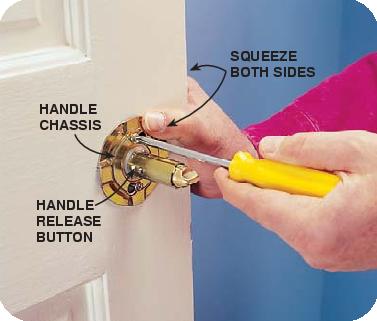When a door just won?t open, there?s no need to break it down. All it would take is dismantling its handle and piecing it back together. The key to fixing a faulty door is in knowing how to fix a door handle.
If a door handle had been screwed on too tightly, there are two typical problems that could result from this. The first problem is that the backplate which supports the handle would pinch the door as well as the latch or lock, which would stop the spring within the lock from functioning properly. The second problem that an over-tightened door handle can cause is that it can produce friction on the spring within the backplate. In order to set things right, the screws holding the handle should be slightly loosened a quarter of a turn each. Test the handle to see if it is working normally. If not, slacken the screws some more.
The internal springs present in most door handles should be lubricated properly to keep it from grinding against the backplate?s inners. In order to inspect the handle for grinding, remove it first from the door. Then holding the backplate on one hand, the lever is operated with the other hand to check if it grinds. If it does, daub the spring with a bit of either petroleum jelly or grease. The handle is then moved a few times to work the grease or jelly into the spring mechanism. If all goes well, the handle should be freely moving and is ready to be refitted back into the door.
There are certain door handles that have a long neck inside where the square spindle bar is located. These may sometimes bind next to the door, keeping the handle from turning back to its usual position. To fix this, the handle should be removed from the door and laid on the table. Normally, the handle should lie flat, but if it rocks, it means that the neck is overhanging further than the backplate. A hole will have to be drilled on each side of the door which would be big and deep enough to permit the backplate to flatly rest onto the door.
There are some doors which had been fitted with really cheap door latches just to save money while building the door. It would be very easy for the spring mechanism in such cheaply-made door handles to fail. To see to this problem, the handle is removed from the door and the latch is pulled out. The latchbolt is then pressed using one?s own finger to see if it would spring back out. If it does not fully spring out or if it is too slow in doing so, the latch should be replaced with a new one having the same size but with a much higher quality.
A door in a new house, or even a new door that had just been hung, would occasionally drop after sometime. When this occurs, the latchbolt would bind adjacent to the keep plate. One would be able to notice this from the scrapes and abrasions that would appear on the keep plate and even on the latchbolt. To solve the problem, one would merely have to slightly reposition the keep plate a bit lower along the door frame.
Though it is the smallest visible part of the door, the handle is actually its most intricate component. Learning how to fix a door handle entails taking it apart and familiarizing oneself with its inner workings in order to diagnose the problem and know how to repair it accordingly.



